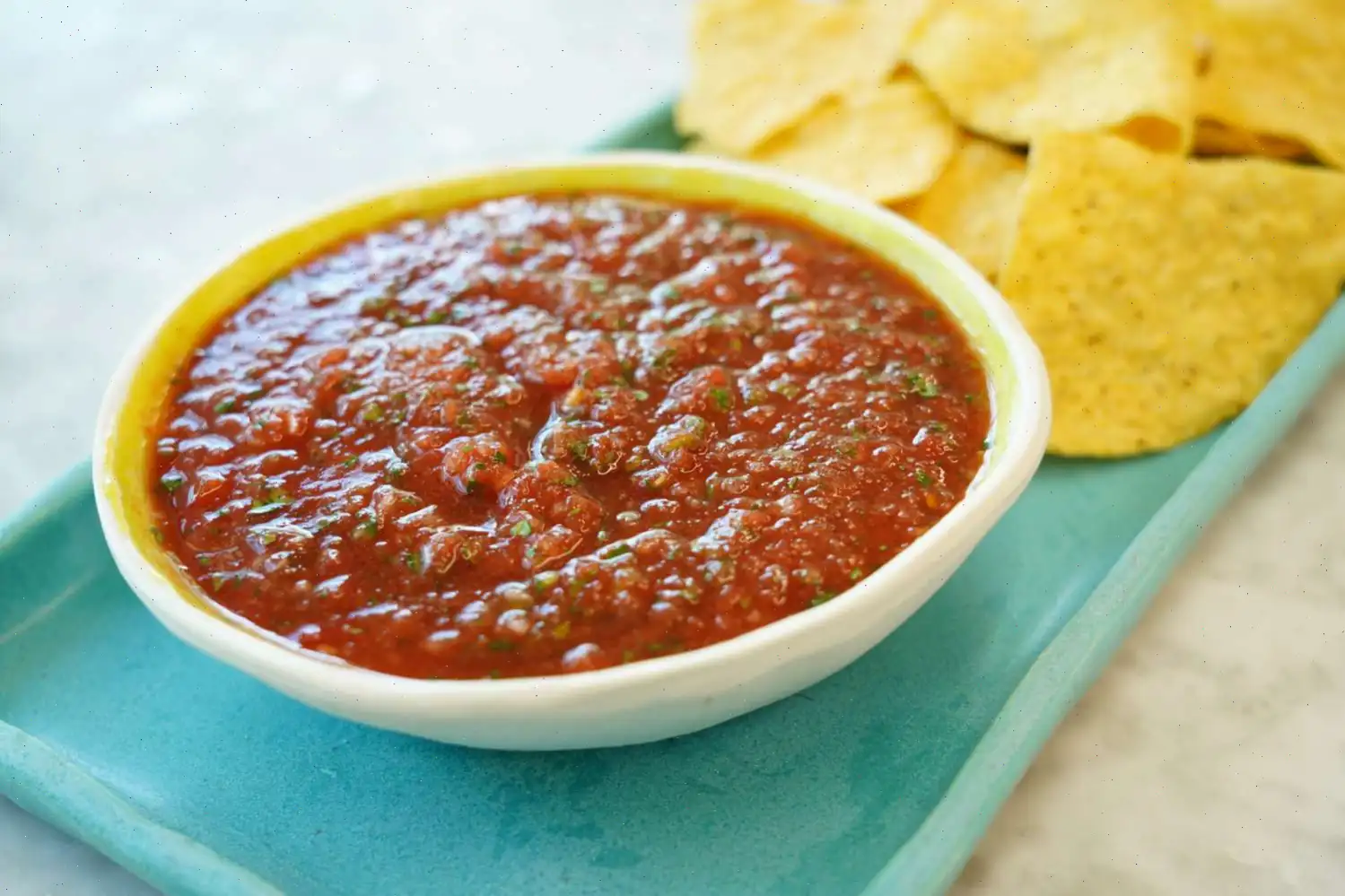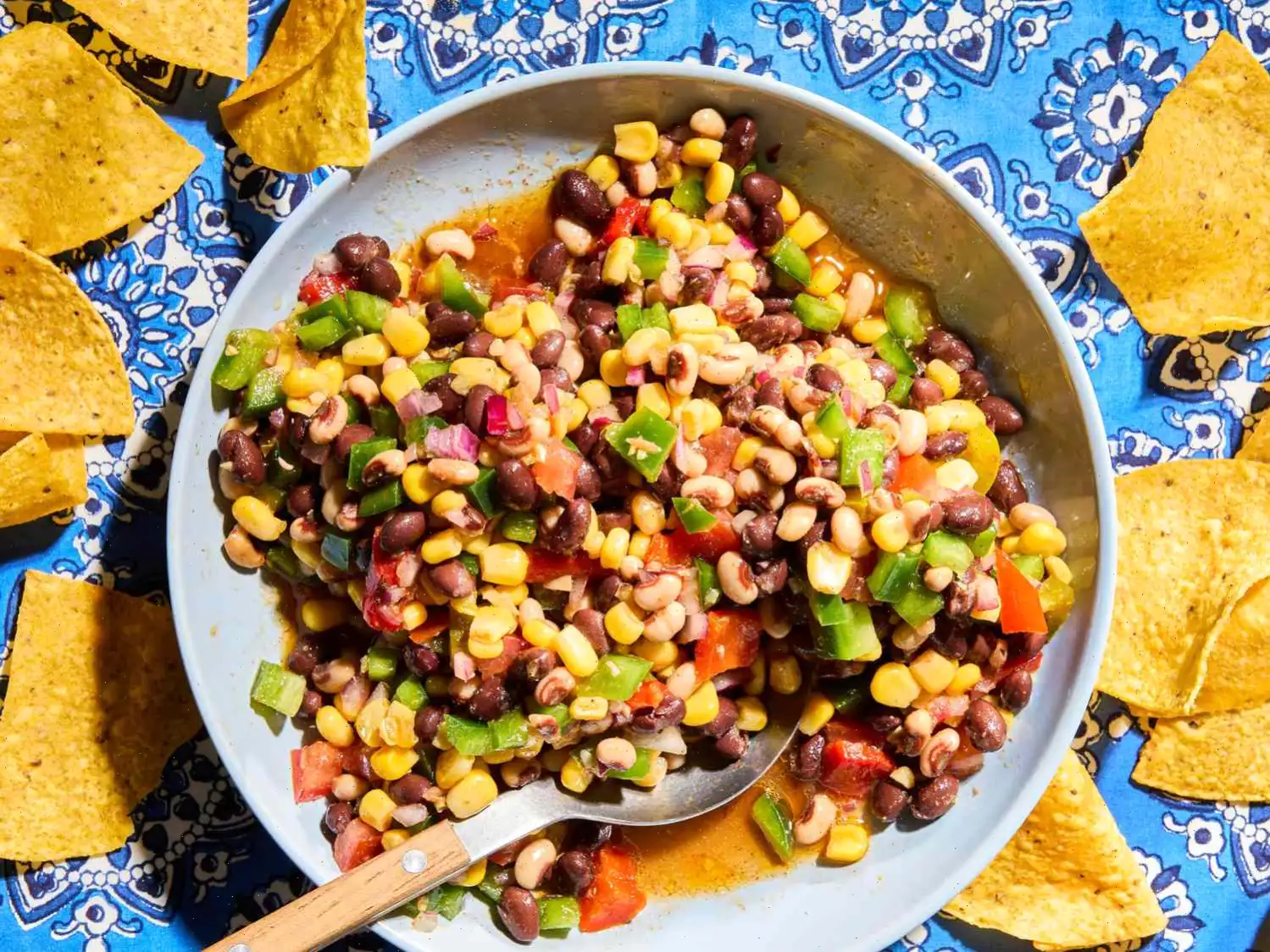
Fresh Restaurant-Style Salsa Recipe
Ingredients
This recipe was developed at its original yield. Ingredient amounts are automatically adjusted, but cooking times and steps remain unchanged. Note that not all recipes scale perfectly.
- 1 (28 ounce) can Roma tomatoes, drained
- 4 small Roma tomatoes, quartered
- 1 cup chopped white onion
- 1 clove garlic, smashed
- 1 small bunch fresh cilantro, stems removed
- 1 serrano pepper, seeded and chopped
- 1 medium jalapeo pepper, seeded and chopped
- 1 tablespoon freshly squeezed lime juice
- 1 teaspoons kosher salt
- teaspoon ground cumin
Directions
Step 1: Combine the canned Roma tomatoes, fresh Roma tomatoes, chopped onion, and smashed garlic in a food processor. Pulse the mixture 5 times to chop the ingredients.
Step 2: Add the fresh cilantro, serrano pepper, jalapeo pepper, lime juice, kosher salt, and ground cumin to the processor. Process for 10 seconds to blend everything together.
Step 3: Continue pulsing until you reach the desired consistency. If you prefer a smoother texture, process it a bit longer.
Recipe Tip
If you like a spicier salsa, leave the seeds in the jalapeo pepper.
Nutrition Facts (per serving)
| Calories | 11 |
| Fat | 0g |
| Carbohydrates | 3g |
| Protein | 1g |
| Sodium | 168mg |
| Dietary Fiber | 1g |
| Total Sugars | 1g |
| Vitamin C | 6mg |
| Calcium | 14mg |
| Iron | 0mg |
| Potassium | 102mg |
Servings Per Recipe
24 servings
Additional Notes
Percent Daily Values are based on a 2,000 calorie diet. Your daily values may be higher or lower depending on your calorie needs.
Nutrition information is not available for all ingredients. The amount is based on available nutrient data. If you are following a medically restrictive diet, please consult your doctor or registered dietitian before preparing this recipe for personal consumption.
Fresh salsa is a beloved appetizer in many Mexican restaurants, and the Fresh Restaurant-Style Salsa is a perfect example of this classic dish. With a balance of fresh tomatoes, tangy lime, and a touch of heat from peppers, it's a go-to snack served alongside chips or as a topping for tacos and burritos. But beyond its taste, this salsa carries with it a rich history and regional diversity. Here, well explore the origin, regional variations, and fun facts about this iconic dip.
Origin and History of Salsa
Salsa, which simply means sauce in Spanish, is deeply embedded in Mexican cuisine. Its roots can be traced back to the Aztecs, who used tomatoes, chili peppers, and other ingredients native to Mesoamerica. However, the modern version of salsa as we know it today, especially the fresh, chunky variety, became popular after tomatoes were introduced to Europe from the Americas in the 16th century.
The Fresh Restaurant-Style Salsa is a modern take on traditional salsa, often made in large batches for serving in restaurants. It has gained a reputation for its perfect balance of flavors, often achieved by using a combination of fresh and canned tomatoes, onions, garlic, cilantro, and various peppers. This type of salsa is commonly enjoyed as a dip in casual dining settings, mimicking the styles of popular chain restaurants in the U.S. like Chilis or El Torito.
Regional Variations
While salsa is common across all regions of Mexico, the Fresh Restaurant-Style Salsa is most closely associated with the northern regions of Mexico and the southwestern United States, particularly in areas with a strong Mexican influence. The northern parts of Mexico often feature salsas made with roasted tomatoes, and fresh ingredients are mixed with varying levels of heat from peppers like serrano or jalapeo. In contrast, salsa verde, made with tomatillos and typically more tangy, is a staple in central and southern Mexico.
In the U.S., restaurant-style salsa is adapted to cater to local tastes and is often served as a milder option for broader audiences. The use of canned tomatoes in this recipe helps create a smoother consistency, making it more suited for dipping with chips. Some variations may include a heavier use of lime or additional herbs like oregano to enhance the flavor.
Differences from Similar Dishes
Many people confuse salsa with pico de gallo, but the two are distinct. While both feature fresh tomatoes and similar ingredients, pico de gallo (meaning "roosters beak") is a raw, chunky salsa that uses only fresh tomatoes, onions, cilantro, and lime, with minimal seasoning. On the other hand, Fresh Restaurant-Style Salsa often uses a combination of fresh and canned tomatoes and can be blended to a smoother consistency, with added ingredients like garlic and cumin to deepen the flavor.
Another popular salsa is salsa verde, which is made with green tomatoes or tomatillos instead of the ripe red tomatoes typically found in fresh salsa. Salsa verde offers a tangier flavor profile and can sometimes be spicier depending on the type of peppers used.
Where to Serve Fresh Salsa
Fresh salsa is a staple in Mexican cuisine and is often served in Mexican restaurants as an appetizer or side dish. In restaurants, it's typically paired with tortilla chips and served alongside guacamole or other dips. This type of salsa is also perfect for adding flavor to tacos, burritos, grilled meats, or even scrambled eggs. At home, its commonly enjoyed during casual gatherings or BBQs, where its served as a refreshing dip or topping.
In addition to its place in Mexican cuisine, Fresh Restaurant-Style Salsa has become a popular appetizer in chain restaurants in the U.S., where it is often served alongside baskets of warm tortilla chips. Its popularity has transcended borders, becoming a favorite snack for many around the world.
Interesting Facts About Salsa
1. Salsa is one of the most consumed condiments in the United States, surpassing even ketchup in popularity.
2. In 2015, it was reported that salsa consumption in the U.S. topped 200 million pounds annually.
3. The word "salsa" has its origins in the Spanish language, and it is simply a term used to describe any sauce, but over time, it became specifically associated with tomato-based sauces in the U.S. and worldwide.
4. There are over 200 different types of salsa, including various heat levels and ingredient combinations, showcasing the versatility of this iconic condiment.
5. Despite its popularity in the U.S., salsa remains a largely homemade dish in Mexico, with different families and regions creating their own unique variations.
Conclusion
Whether you're enjoying a bowl of Fresh Restaurant-Style Salsa at your favorite Mexican restaurant or making it at home, this dish is an essential part of Mexican culinary tradition. It offers a perfect blend of fresh, tangy, and spicy flavors that appeal to a wide range of palates. From its historical roots to its regional variations, salsa has become a universal favorite, bringing people together to share in its simple yet bold taste.
FAQ about Fresh Restaurant-Style Salsa Recipe
Comments
Andrew Perez
08/09/2024 12:22:48 AM
Review Rewritten: This dish was a huge hit at the gathering. It received rave reviews from everyone. It makes a large portion, but it will definitely be finished quickly. We couldn't decide if it tasted more like Chili's or El Torito, but it was definitely a big success. I kept the seeds in both peppers for an extra kick (it wasn't too spicy) and added an additional clove of garlic.








